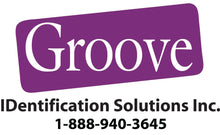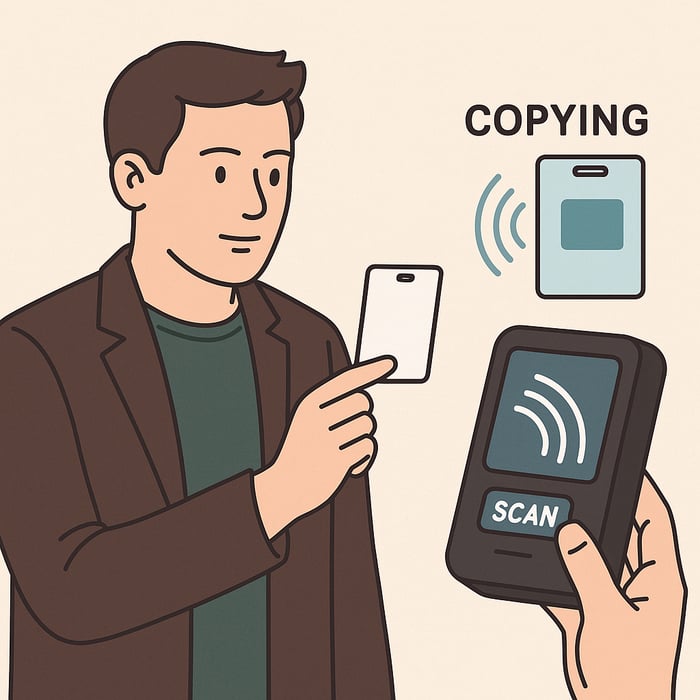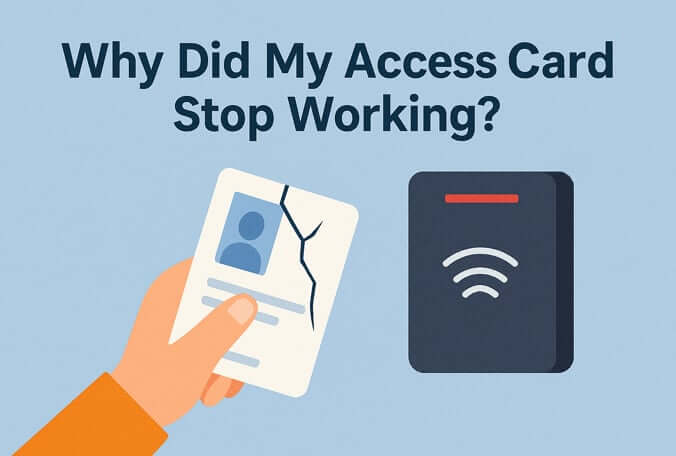Introduction
Anti-clone access cards are a critical step in protecting modern organizations from one of the fastest-growing security threats: card cloning. With cheap devices easily found online, criminals can duplicate older access credentials in seconds. Choosing the right card technology is no longer optional—it’s essential. HID, through advanced solutions like HID Seos cards and Signo readers, has become a leader in fighting cloning attacks with next-generation encryption and trusted identity technology.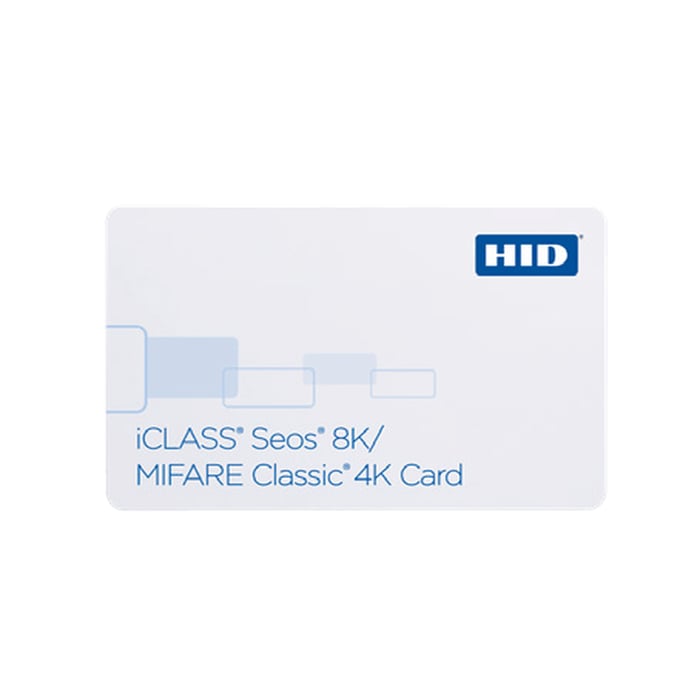
The Rise of Card Cloning
In the early days of access control, proximity cards and magnetic stripe cards dominated the landscape. While affordable and convenient, these cards rely on outdated technology that transmits data without encryption. Criminals quickly learned how to exploit this weakness.
Cheap Tools, Big Risks
A quick search on Amazon, eBay, or similar sites reveals dozens of devices marketed as “card copiers” or “RFID duplicators.” Many of these handheld tools cost less than $50 and are capable of reading and writing basic 125kHz Proximity credentials. That means a thief could scan a legitimate card from a pocket, purse, or lanyard, then instantly duplicate it onto a blank card for unauthorized entry.
The problem is not theoretical. Reports of unauthorized access, tailgating incidents, and breaches linked to cloned credentials are rising worldwide. For businesses, this risk translates into theft, data loss, and potentially severe liability.
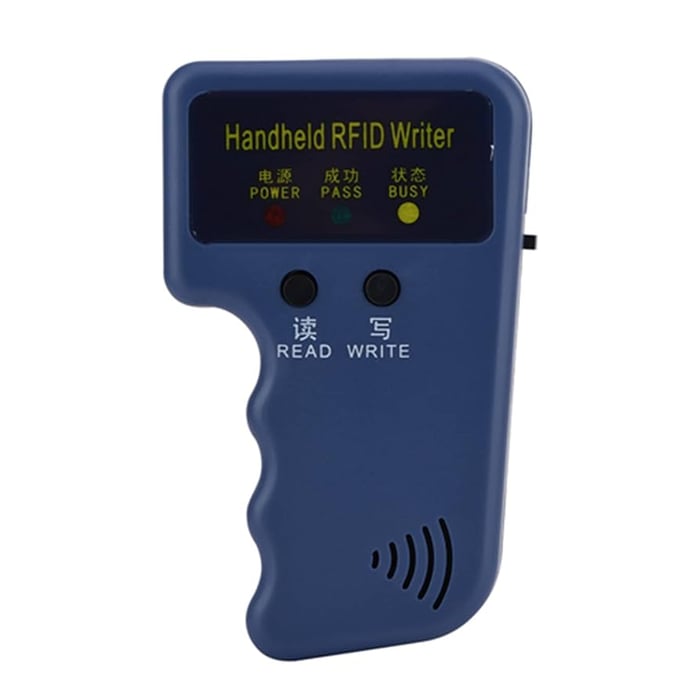 Low-cost RFID cloning device used to duplicate legacy access card
Low-cost RFID cloning device used to duplicate legacy access cardHow Card Cloning Works
To understand why anti-clone access cards are necessary, it’s important to see how cloning is carried out:
Scanning the Card – A cheap RFID reader is held near the card to capture the data being broadcast. With older cards, this data is unencrypted and easily intercepted.
Copying to a Blank Card – The device writes the captured data to a low-cost blank proximity card.
Testing the Duplicate – The cloned card is then presented at a reader, functioning identically to the original.
The entire process takes less than two minutes. Criminals don’t need advanced technical skills; the tools are designed to be easy enough for anyone to use.
The Limitations of Legacy Access Cards
Not all cards are equally vulnerable, but legacy formats like:
125kHz Proximity Cards
Magnetic Stripe Cards
Early MIFARE Classic Cards
…are all known for their weaknesses. Once considered secure, these credentials are now outdated. They lack encryption, use predictable identifiers, and can be easily cloned with off-the-shelf tools.
Organizations that still rely on these cards are effectively leaving the door open to anyone with a card copier.
What Are Anti-Clone Access Cards?
Anti-clone access cards are designed to resist duplication by using strong encryption, mutual authentication, and unique identifiers. These cards make it virtually impossible for an attacker to copy credentials using consumer-grade devices.
Key features include:
Encrypted Communication – Data is transmitted in a secure, encrypted format that cannot be read by unauthorized devices.
Mutual Authentication – Both the card and reader verify each other before any data is exchanged.
Unique Keys – Each card carries unique, diversified encryption keys that are never repeated.
Future-Proofing – Many modern credentials support software upgrades for added protection over time.
By upgrading to anti-clone cards, organizations significantly reduce the risk of unauthorized entry and cloning-based attacks.
HID Global: Leading the Fight Against Card Cloning
When it comes to anti-clone access cards, HID Global is the gold standard. For decades, HID has been trusted by governments, healthcare, education, and Fortune 500 companies worldwide. Their technologies, particularly HID Seos cards and HID Signo Readers, represent the future of secure access control.
HID Seos Cards
HID Seos cards are a new generation of access credentials designed to resist cloning. They replace older proximity and iCLASS cards with advanced features, including:
AES-128 Encryption – Government-grade encryption ensures data cannot be intercepted or copied.
Secure Identity Objects (SIOs) – Each card stores identity data in a secure container that resists tampering.
Diversified Keys – Each card has unique encryption keys, preventing mass duplication.
Multi-Application Support – Seos can be used not only for physical access but also for logical access, secure printing, and cashless vending.
HID Seos cards are widely recognized as among the most secure credentials available today.
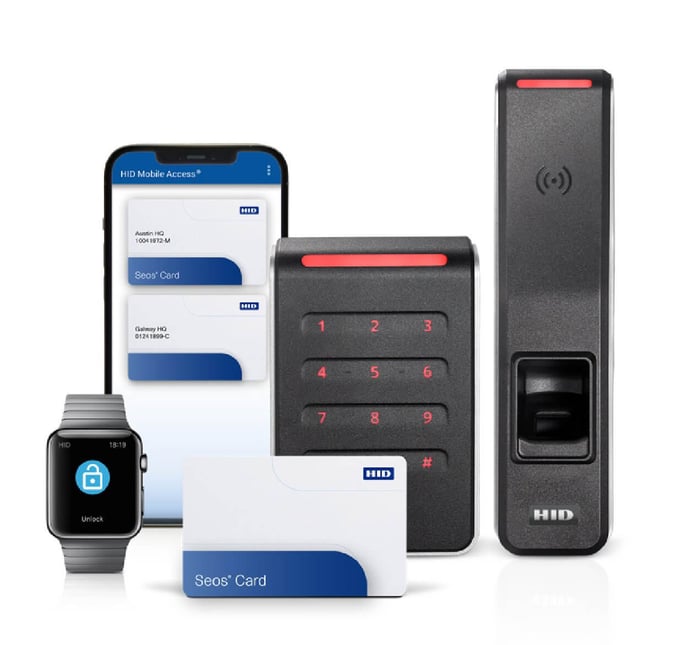
HID Signo Readers
While anti-clone access cards are essential, they only reach their full potential when paired with advanced readers. That’s where HID Signo Readers come in.
Features include:
Support for Seos and Legacy Cards – Ensures a smooth transition for organizations upgrading security.
Automatic Firmware Updates – Keeps systems up to date against evolving threats.
Strong Encryption – Uses advanced cryptography to authenticate both the card and reader.
Mobile Credential Support – Works seamlessly with HID Mobile Access, allowing phones to replace cards.
Together, HID Seos cards and Signo readers form a layered defense against cloning and unauthorized access.

Why Anti-Clone Technology Matters More Than Ever
The threat landscape is evolving. As workplaces become more hybrid and buildings support multiple tenants, access control systems must balance convenience with strong security. Legacy cards no longer meet this requirement.
Real-World Impacts of Card Cloning
Corporate Espionage – Competitors gaining access to secure R&D areas.
Theft and Vandalism – Unauthorized entry into warehouses or offices.
Data Breaches – Access to server rooms where sensitive information is stored.
Safety Risks – Intruders entering schools, hospitals, or government buildings.
In each of these cases, anti-clone technology such as HID Seos cards prevents criminals from simply copying their way inside.
How to Choose an Anti-Clone Access Card
If you’re evaluating credentials for your organization, here’s what to look for:
Encryption Standard – Ensure the card uses AES or similar strong encryption.
Mutual Authentication – Prevents spoofing between card and reader.
Future-Ready – Cards should support mobile credentials and software updates.
Vendor Reputation – Stick with trusted providers like HID Global.
Reader Compatibility – Pair secure cards with readers designed to support them, such as HID Signo.
Transitioning from Legacy Cards
Upgrading an access system doesn’t need to happen overnight. HID solutions make it possible to migrate gradually:
Use multi-technology cards that support both legacy and Seos formats.
Deploy Signo readers capable of reading old and new cards.
Phase in new credentials by department or location.
This approach allows organizations to increase security without disrupting day-to-day operations.
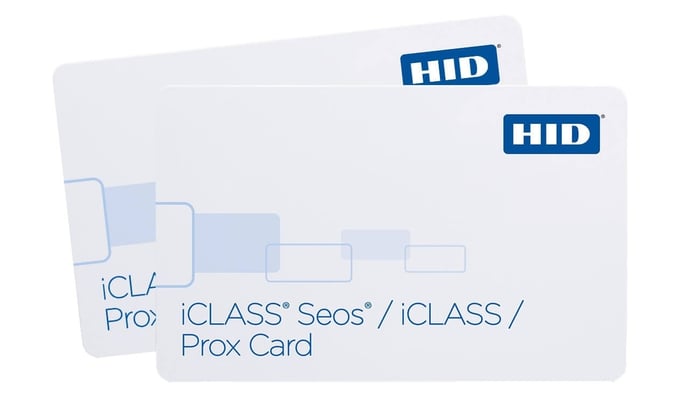 Multi-Tech Migration Card
Multi-Tech Migration CardThe Role of Mobile Credentials
In addition to anti-clone cards, mobile credentials are emerging as a powerful tool. HID Mobile Access allows users to authenticate with smartphones or wearables. Because the credentials are stored securely in the cloud and protected by the device’s native security (fingerprint, face ID, PIN), they offer strong resistance against cloning.
Paired with HID Signo readers, mobile credentials provide flexibility while maintaining security.
Cost vs. Risk: Why It’s Worth the Investment
Some organizations hesitate to upgrade because of cost. However, the expense of switching to HID Seos cards and Signo readers is minor compared to the potential losses of a cloned-card breach.
Cost of Replacement – Stolen assets, damaged property, and downtime.
Reputation Damage – Clients lose trust after a security failure.
Compliance Fines – Many industries face penalties if unauthorized access leads to data loss.
By investing in anti-clone credentials, businesses protect their people, assets, and reputations.
Common Myths About Anti-Clone Cards
“They’re too expensive.”
While slightly higher in price, the long-term savings in risk reduction outweigh the initial cost.“They’re hard to implement.”
HID solutions are designed for seamless migration. Multi-tech cards and Signo readers make it easy.“Cloning isn’t a real threat.”
With card copiers sold openly online, cloning is more widespread than most realize.
Final Thoughts
Anti-clone access cards are no longer a “nice-to-have” — they’re a necessity in today’s security landscape. Criminals can buy cloning devices online for under $50, making legacy cards like 125kHz Proximity a serious liability.
By upgrading to HID Seos cards and HID Signo readers, organizations gain strong encryption, tamper resistance, and future-ready identity management. Whether for a hospital, university, government office, or private enterprise, HID solutions provide the trusted protection needed in a world where cloning threats continue to rise.
For businesses in Canada and beyond, making the move to anti-clone access cards is one of the smartest security investments available today.
Ready to Upgrade to Anti-Clone Access Cards?
At Groove Identification Solutions, we understand the importance of protecting your organization from the growing threat of card cloning. As an Authorized HID Global Solution Provider, we proudly supply HID Seos cards, HID Signo readers, and complete secure ID solutions trusted by healthcare, education, government, and enterprise customers across Canada.
Whether you’re looking to replace legacy proximity cards, migrate to Seos, or add mobile credentials, our team is here to help with expert advice, competitive pricing, and ongoing support.
Contact Groove Identification Solutions today at 1-888-940-3645 or visit groovebadges.com to secure your organization with HID’s most advanced anti-clone access technology.
